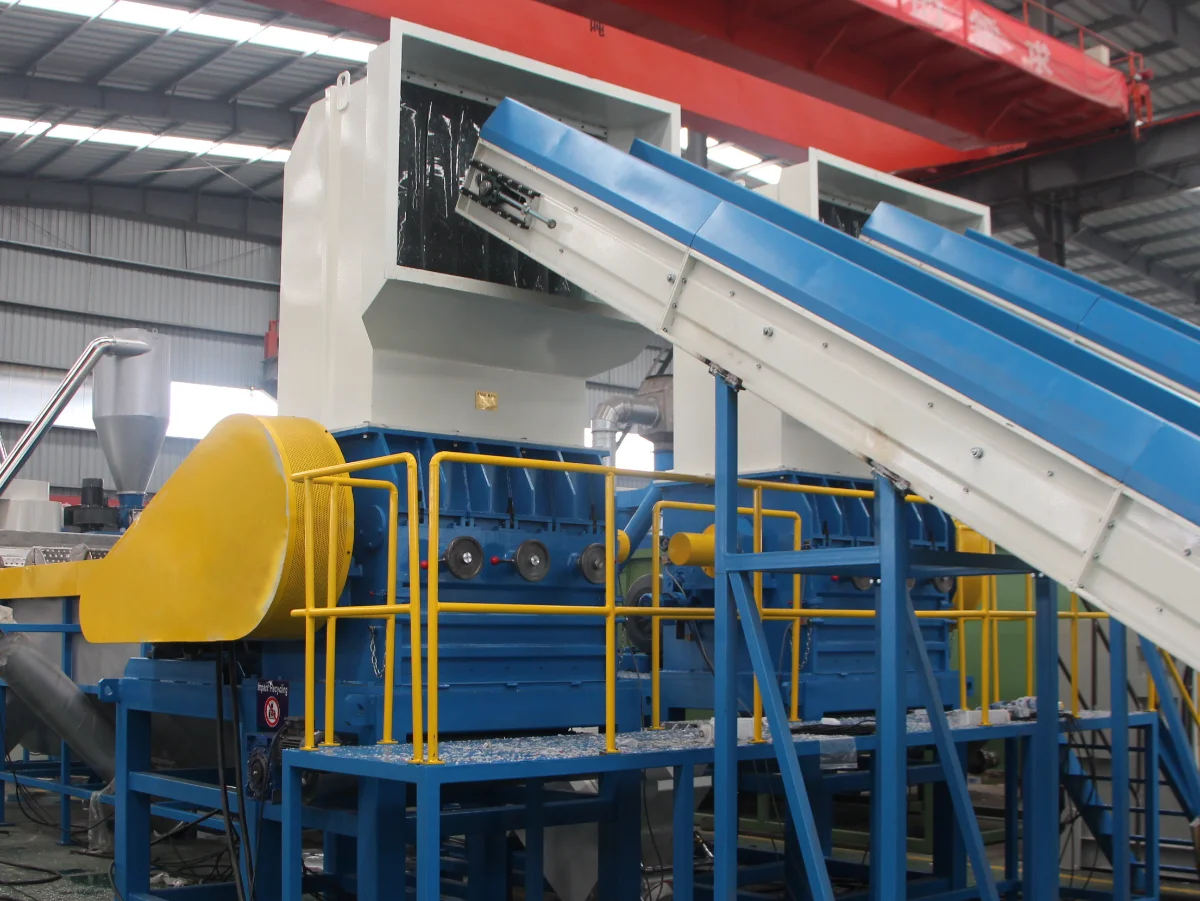Wet Plastic Slijpmachines: Een Uitgebreide Gids voor Recyclingoperaties
Wet plastic slijpmachines staan centraal in moderne, efficiënte plasticrecyclinginstallaties. Door water direct in het verkleiningsproces in te voeren, doen deze machines meer dan alleen plastic granuleren; ze wassen materialen tegelijkertijd voor, verlengen de levensduur van de apparatuur en creëren een veiliger werkomgeving. Voor recyclingprofessionals en plantbeheerders is het begrijpen van de mechanica, voordelen en toepassingen van deze technologie essentieel voor het optimaliseren van de doorvoer, het verbeteren van de kwaliteit van het recyclaat en het verhogen van de winstgevendheid.
Deze gids biedt een gedetailleerde verkenning van natte plastic slijpmachines, hun werking, de cruciale verschillen tussen nat en droog slijpen, en praktisch advies voor het kiezen en onderhouden van de juiste apparatuur voor uw specifieke behoeften. We zullen verkennen hoe het integreren van een hoge prestatie natte granulator uw recyclinglijn kan transformeren.

Wat is een Wet Plastic Slijpmachine?
Een natte plastic slijpmachine, vaak een natte granulator genoemd, is een stuk verkleiningsapparatuur dat een hoogsnels rotor met scherpe messen gebruikt om grote plastic voorwerpen te snijden in kleine, uniforme vlokken of hergebruikte materialen. Zijn kenmerkende eigenschap is de continue injectie van water in de snijruimte tijdens de werking.
Dit water vervult meerdere cruciale functies:
- Koeling: Het koelt actief de rotor, messen en het plastic zelf, waardoor het materiaal niet smelt door wrijving. Dit is vooral belangrijk voor plastics met een lage smelttemperatuur zoals LDPE-film.
- Schoonmaken: De waterstroom fungeert als een krachtig schoonmaakmiddel, het wassen van vervuiling zoals aarde, zand, papieretiketten en voedselresten van de plastic oppervlakte af.
- Smering: Het bevat olie die de snijactie smeren, wat de wrijving en slijtage op de messen vermindert.
- Stofbestrijding: Het water vangt fijn plasticpoeder en stof op, voorkomt dat deze in de lucht komt en creëert een schoner, veiliger werkomgeving voor operators.
Het resultaat is een slurry van schone plasticflakes en vervuild water, die vervolgens gescheiden worden. De schone flakes kunnen doorgaan naar de volgende fase van het recyclingsproces, zoals een wrijvingswasmachine of een drijvingsbak, met een aanzienlijk voordeel op het gebied van schoonheid.
Het Droogmalenproces: Een Stap-voor-Stap Uitleg
Het begrijpen van de operationele stroom van een nat plastic maler helpt zijn waarde binnen een groter recyclingsysteem te verduidelijken. Hoewel de ontwerpen tussen fabrikanten variëren, blijft het kernproces consistent.
- Materiaaltoevoer: Voorvermalen of hele plasticvoorwerpen, zoals PET-flessen of HDPE-emballages, worden in de hopper van de granulator geplaatst, meestal via een transportband.
- Waterinjectie: Terwijl het materiaal de snijkamer binnenkomt, spuit een systeem van neuzen voortdurend water op het plastic en de snijcomponenten. De hoeveelheid en druk van het water kunnen vaak worden aangepast op basis van het materiaaltype en het vervuilingniveau.
- Groottevermindering (Granulering): Een zware rotor die op hoge snelheid (meestal 400-600 tpm) draait, drijft het plastic tegen statische bedmessens. De snijactie van de rotormessens tegen de bedmessens snijdt het materiaal in kleinere stukken.
- Scheiding en Maten: De snijkamer is omsloten door een gatenstaal. Het materiaal blijft binnen de kamer en wordt voortdurend gesneden, totdat het klein genoeg is om door de gaten in het staal te passeren. De maat van de gaten in het staal bepaalt de uiteindelijke maat van de schilfers.
- Afvoer: De mengeling van correct geconcentreerde plastic schilfers en water verlaat het apparaat via een afvoerpoort aan de onderkant. Deze slurry wordt vervolgens overgebracht, vaak met behulp van een spoelconveyor of pomp, naar het volgende onderdeel in de wassingslijn.
Vochtig Malen versus Droog Malen: Een Directe Vergelijking
Voor elke recyclingsoperatie is de keuze tussen een vochtig en een droog granulaatapparaat een belangrijke. Een droog granulaatapparaat werkt zonder water en vertrouwt op luchtinsuus om het materiaal af te voeren en stof te controleren. Hier is hoe ze zich vergelijken op cruciale operationele parameters:
| Functie | Vochtig Plastic Malen Machine | Droog Plastic Malen Machine |
|---|---|---|
| Schoonmaakefficiëntie | Hoog. Integreert een voorwassingstraat, die effectief oppervlakkige vuil, papier en lijm verwijdert. | Laag. Verontreinigingen worden samen met het plastic granuleerd, wat een intensievere afvoerschoonmaak vereist. |
| Stofbeheersing | Uitstekend. Water onderdrukt bijna alle stof, wat de luchtkwaliteit en veiligheid op de werkplek verbetert. | Vereist een aparte, energiezuivere luchtafvoer- en filtratiesysteem om stof te beheren. |
| Levensduur van het blad | Langer. Water koelt en smeert messen, wat slijtage door hitte en wrijving vermindert. Schurende materialen zoals zand worden weggespoeld, wat voortijdige veroudering voorkomt. | Korter. Messen worden blootgesteld aan hogere temperaturen en meer wrijving, wat frequentere slijp- of vervanging nodig maakt. |
| Energieverbruik | Potentieel lagere totale systeemenergiegebruik, omdat het de belasting op het afvoersysteem van het wassysteem vermindert. | De granulator zelf gebruikt mogelijk iets minder energie, maar de totale systeemenergie is hoger vanwege de behoefte aan krachtige stofopvangsystemen. |
| Ideale toepassingen | Post-consumer plastics (PET-flessen, HDPE-containers), landbouwfolies en andere besmette materialen. | Schoon, in-house industriële afvalstoffen (bijv. injectiegieterij spuitgoot, leidingen) waar besmetting geen probleem is. |
| Onderhoud | Vereist beheer van het watersysteem (filters, pompen). Minder frequente messenonderhoud. | Behoeft aan regelmatige schoonmaak van stofopvangfilters. Meerdere malen per week messenonderhoud. |
Hoofdvoordelen van het Integreren van Nat Grondpersen in Uw Werkproces
Het overnemen van nat plastic grondpersen biedt tastbare voordelen die direct invloed hebben op de operationele efficiëntie en de kwaliteit van het eindproduct. De Vereniging van Plastic Recyclers (APR) stelt strenge richtlijnen voor de kwaliteit van recyclaat, en nat grondpersen helpt deze normen te bereiken.
Superieure verwijdering van verontreinigingen
Voor post-consumptie plastic is vervuiling de belangrijkste uitdaging. Nat grondpersen aanpakken dit aan. De krachtige, continue waterstroom lost vuil, overblijvende vloeistoffen en voedselresten los. Het helpt ook om papier en lijm van etiketten te scheiden, wat een cruciale stap is in het produceren van hoge-pure PET korrels voor fles-naar-fles recycling.
Verlengde Levensduur van Messen en Machines
De operationele kosten van een granulator worden sterk beïnvloed door het onderhoudsschema voor zijn messen. Door de snijoppervlakken constant te koelen, voorkomt een nat grinder dat messen hun hardheid en temperatuur verliezen door overmatige hitte. Dit vertaalt zich direct in langere tussenpozen tussen scheren en vervanging, wat de downtime en kosten voor vervangingsonderdelen vermindert. Het smeringseffect minimaliseert ook de belasting op de lagers en de roterende assembly.
Verbeterde Veiligheid op de Werkvloer en Milieuvoorschriften
Plasticstof is een ernstige beroepsrisico. Het kan een respiratoire irriterend zijn en, bij hoge concentraties, ontvlambaar. Zoals de Occupational Safety and Health Administration (OSHA) opmerkt, is het beheer van ontvlambaar stof een belangrijke veiligheidsprioriteit. Nat grondpersen verwijdert effectief luchtgevoerde stof aan de bron, creëert een veel veiligere omgeving en vereenvoudigt de naleving van luchtkwaliteitsregels.
Verbeterde Kwaliteit en Waarde van Hergebruikte Korrels
Het uiteindelijke doel van recycling is het produceren van een hoge-kwaliteits grondstof. Schoonere korrels hebben een hogere prijs op de markt. Door een agressieve voorwasmethode uit te voeren, produceren nat grondpersen korrels die aanzienlijk schoner zijn dan die van een droog proces. Dit vermindert de belasting op de volgende wassystemen, waardoor deze effectiever kunnen werken en een eindproduct met lagere vervuildheidsniveaus oplevert.
Belangrijke Toepassingen en Geschikte Plasticmaterialen
Vochtige plasticmolen zijn veelzijdig, maar ze presteren uitblinkend in specifieke toepassingen waar hun schoonmaakcapaciteiten de meeste waarde bieden.
- PET-flessen: Dit is de primaire toepassing. Vochtige molens verwijderen efficiënt etiketten, lijm en drankresten, waardoor schone schillen ontstaan die klaar zijn voor de flotatiestorters.
- HDPE-vaten: Melkkanen, sopflessen en andere HDPE-vaten worden effectief verwerkt. Het water helpt het productrestant en vuil af te spoelen.
- Besmette Plasticfolie: Landbouwfolie (mulchfolie, glastuinbouwdekken) zijn vaak zwaar vervuild. Vochtige malen bieden de benodigde agressieve schoonmaak om hen recycleerbaar te maken.
- Gemengde stijve kunststoffen: Ballen gemengde post-consumerplasticen van straatafval profiteren aanzienlijk van het geïntegreerde wassysteem.
Bij Energycle-machine, wij ontwerpen onze apparatuur om de zwaarste materialen aan te kunnen, wat ervoor zorgt dat ze betrouwbaar presteren in een breed scala aan eisende toepassingen.
Kies de Juiste Vochtige Plasticmolen voor Uw Behoeften
Het kiezen van de juiste machine vereist een zorgvuldige analyse van uw specifieke operationele vereisten. Overweeg deze factoren:
- Doorvoercapaciteit: Hoeveel materiaal moet u per uur verwerken (kg/uur of lbs/uur)? Kies een machine met een capaciteit die comfortabel boven uw huidige behoeften uitkomt, zodat u ruimte heeft voor toekomstige groei.
- Ingangsmateriaal: Wat is het type, formaat en vervuilingniveau van uw plastic afval? Heavily contaminated or bulky materials may require a machine with a larger cutting chamber and a more robust rotor.
- Gewenste korrelgrootte: De uiteindelijke korrelgrootte wordt bepaald door het zeil. Zorg ervoor dat de fabrikant schermen kan leveren met de juiste opening doorsnede voor uw doelstelling.
- Motorvermogen: De motor (gemeten in HP of kW) moet krachtig genoeg zijn om uw zwaarste materialen aan te kunnen zonder te staken. Ondermachtige machines leiden tot lage doorvoer en frequente verstoppingen.
- Constructie en Duurzaamheid: Kies voor machines die zijn gebouwd met zwaarwerkend, slijtvast staal. De snijruimte en de as moeten zijn ontworpen voor gemakkelijke toegang om wisseling van messen en schoonmaak te vergemakkelijken.
Onderhoud en Operationele Best Practices voor Optimaal Prestatie
Om de levensduur en efficiëntie van uw nat plastic granulator te maximaliseren, is een consistent onderhoudsschema onmisbaar.
- Dagelijkse controles: Controleer voor het starten visueel de snijruimte op enige vreemde voorwerpen (zoals metaal) die de messen kunnen beschadigen. Controleer op waterlekkage.
- Onderhoud van het blad: Inspecteer de messen regelmatig op slijtage en schade. Draai en scherf ze volgens de aanbevelingen van de fabrikant. Het handhaven van een nauwkeurige mesopening is cruciaal voor een schone, efficiënte snede.
- Zeilmaintenance: Zorg ervoor dat het zeil vrij is van verstoppingen. Blokkeerde zeeleinden verminderen de uitvoer en kunnen leiden tot oververhitting van het materiaal binnen de ruimte.
- Lagersmering: Volg het aanbevolen smeringsschema voor de aslageringen om vroegtijdige slijtage te voorkomen. Luister naar enige ongewone geluiden die een aslageringsprobleem kunnen indiciëren.
- Waterstelsel Onderhoud: Controleer en reinig de waterinlaatfilters regelmatig om een consistente doorstroming en druk te waarborgen. De kwaliteit van het gebruikte water kan zowel de schoonmaakefficiëntie als de slijtage van het apparaat beïnvloeden.
Door deze praktijken te implementeren, waarborgt u dat uw apparatuur op zijn best presteert. Ons team kan aangepaste ondersteuning en begeleiding bieden op het onderhouden van onze geavanceerde nat plastic granulators voor een lange termijn, probleemloze werking.
Bekijk Specificaties van Nat Plastic GranulatorDe plastic recyclingindustrie ontwikkelt zich voortdurend om aan groeiende vraag naar hoge kwaliteit gerecycleerde materialen te voldoen. Volgens de Amerikaanse Environmental Protection Agency (EPA) blijft de recyclinggraad van plastic een kritisch gebied voor verbetering, waardoor efficiënte verwerkings technologie belangrijker is dan ooit. (Bron: U.S. EPA). Nat plastic grinding machines zijn een direct antwoord op deze uitdaging, biedt een betrouwbare en effectieve methode om vervuild plastic afval om te zetten in een waardevolle bron.



